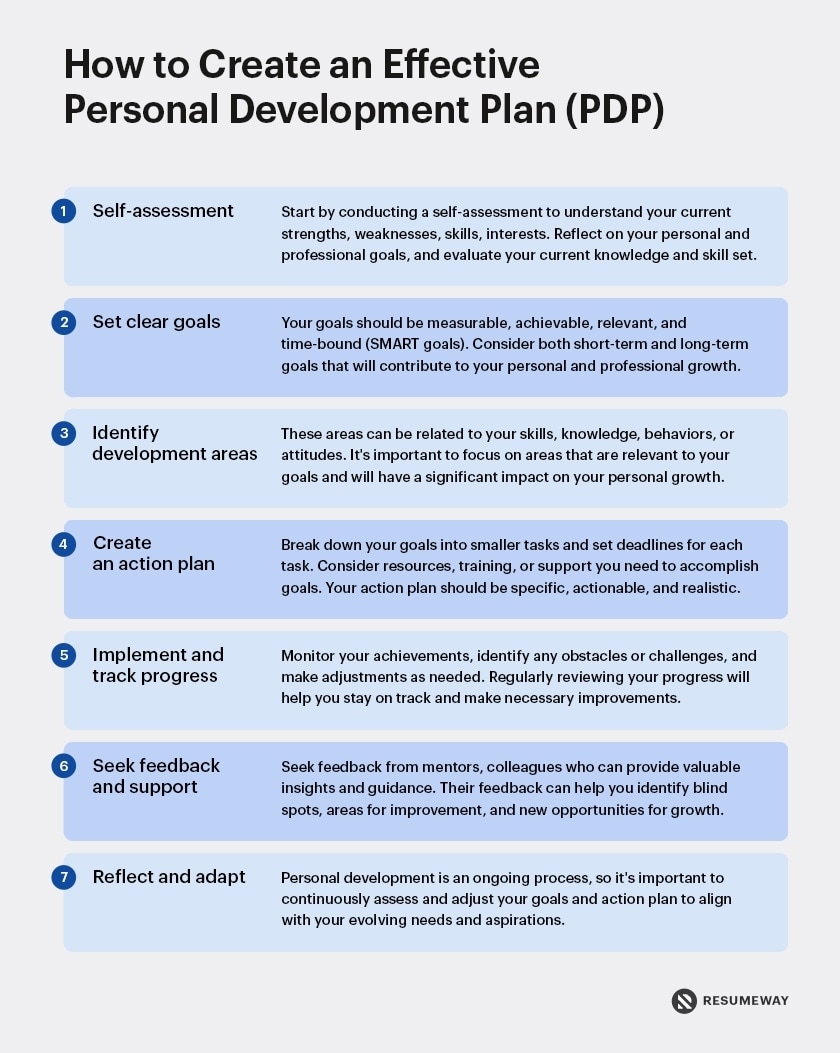


Crafting a personal development plan is a vital step in achieving your goals. Learn how to create a comprehensive plan in 7 steps, including self-assessment, goal setting, identifying development areas, creating an action plan, tracking progress, seeking feedback and support, and reflecting and adapting for continuous growth and improvement.
Table of contents
A personal development plan (PDP) is an action plan that individuals can use to identify their individual goals, strengths, weaknesses, areas for improvement, and the necessary steps to achieve their goals. It is a method of focusing one’s goals into achievable steps, which helps in tracking personal development.
The plan can be aimed at education, career, personal goals, or a combination of these. It provides a clear sense of focus, helps in mapping out a path towards goals, strategizing a plan to achieve them, recording actionable steps, and setting a timeframe for completing them.
The process involves identifying strengths, setting realistic goals, planning the necessary resources and time, and taking action to work on the goals that have been set.

A personal development plan can be beneficial for a wide range of individuals, including employees, professionals, students, and anyone seeking to enhance their personal and professional growth. Here’s a breakdown of who can benefit from a personal development plan:
Creating an effective personal development plan is crucial for anyone looking to grow and improve themselves. Here are 7 key steps to consider when creating your personal development plan:
Identify your strengths, areas for improvement, opportunities, and challenges. What do you want to achieve in the short term and long term? This self-evaluation will assist you in recognizing areas for growth and establishing achievable objectives.
This self-assessment lays the foundation for identifying areas for improvement and setting realistic, achievable goals. It provides a clear understanding of where you currently stand and what you aspire to achieve, enabling you to create a targeted personal development plan that aligns with your ambitions and potential for growth.
Once you have a good understanding of where you stand, it’s time to set clear, achievable goals. These goals should be specific, measurable, attainable, relevant, and time-bound (SMART). Whether it’s improving your skills, advancing in your career, or enhancing your personal relationships, having clear goals will keep you focused and motivated.
Based on your self-assessment and goals, identify the areas where you need to develop. This could be acquiring new skills, improving emotional intelligence, enhancing leadership abilities, or simply working on your personal well-being. Be honest with yourself and prioritize the areas that will have the most impact on your overall growth.
Once you know what you want to achieve and the areas you need to develop, create an action plan. Break down your goals into smaller, actionable steps and set deadlines for each. Identify resources, courses, mentors, or support systems that can help you along the way.
By following these steps, you can create a comprehensive action plan that will guide you toward achieving your objectives while providing a clear roadmap for your personal and professional development.
Set aside time to work on your development goals, and regularly review your plan to ensure you’re on track. Be flexible and open to modifying your plan as necessary.
With these steps, you can effectively put your plan into action, monitor your progress, and make necessary adjustments to ensure you stay on track toward achieving your personal and professional development goals.
Seeking feedback and support from mentors, colleagues, or friends is crucial for personal and professional growth. Their perspectives can offer valuable insights, help individuals stay accountable, and provide guidance in setting and achieving goals. Mentors, in particular, play a significant role in encouraging and enabling another person’s professional or personal development by helping them focus their efforts and set goals
Reflecting on your progress, celebrating achievements, learning from setbacks, and using this reflection to adapt your plan and make necessary changes are essential components of a successful personal development journey. This dynamic approach ensures that you stay aligned with your evolving goals and aspirations, and it empowers you to make continuous progress.
Additionally, learning from setbacks and failures is crucial for growth. By reflecting on what went wrong, what could have been done differently, and what can be learned from the experience, you can avoid making the same mistakes in the future.
Avoid setting unrealistic goals, which can lead to feeling overwhelmed and discouraged. Instead, focus on specific, attainable, and time-bound goals aligned with your long-term vision. Break larger goals into smaller milestones to monitor advancement and acknowledge accomplishments throughout the journey.
Feedback is essential for personal growth. Not seeking feedback from others can deprive you of valuable insights and perspectives for improvement. Embrace constructive criticism to encourage self-awareness and continuous improvement, aiding in personal and professional growth.
Each personal development journey is unique. Comparing yourself to others can lead to feelings of inadequacy and self-doubt. Focus on your own progress, celebrate accomplishments, and learn from setbacks. Embrace your uniqueness and stay focused on personal goals to nurture your development journey.
Regularly reflecting on your progress is crucial for personal development. Failure to reflect can result in a lack of direction and missed growth opportunities. Reflect to assess achievements, challenges, and areas for improvement, and adjust goals and strategies as needed to stay aligned with your aspirations. Dedicate time for introspection and self-assessment to gain valuable insights for personal development and overall well-being.
A: Personal development is important because it allows individuals to assess their own personal qualities and skills. It helps them set goals, improve themselves, and reach their full potential .
A: Creating a personal development plan involves self-reflection and improvement. It is a written account that doubles as a detailed action plan used to fulfill academic, personal, or career-based goals. It helps individuals establish their aims, recognize their strengths and weaknesses, and identify areas for improvement .
A: When creating a personal development plan, it can be helpful to ask yourself the following questions:
No time to polish your resume, cover letter, thank-you letter, or LinkedIn? Our resume-writing experts are ready to check your documents right now.